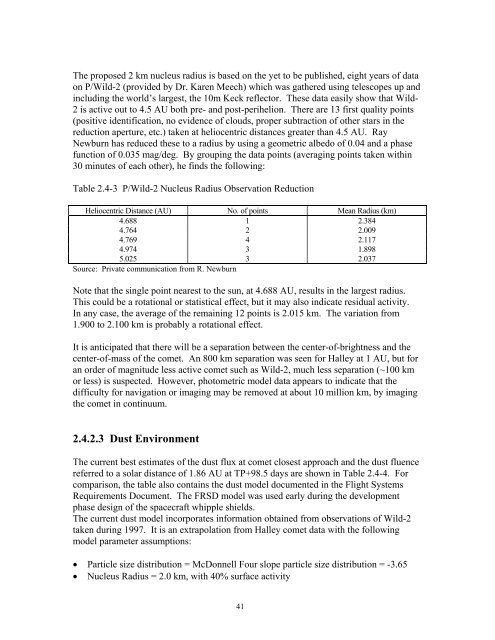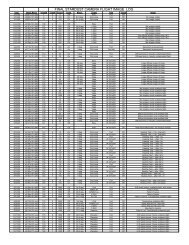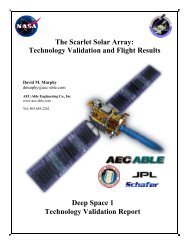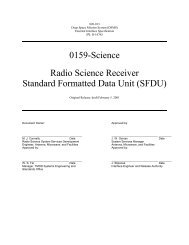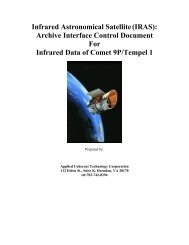MISSION PLAN - PDS Small Bodies Node
MISSION PLAN - PDS Small Bodies Node
MISSION PLAN - PDS Small Bodies Node
Create successful ePaper yourself
Turn your PDF publications into a flip-book with our unique Google optimized e-Paper software.
The proposed 2 km nucleus radius is based on the yet to be published, eight years of data<br />
on P/Wild-2 (provided by Dr. Karen Meech) which was gathered using telescopes up and<br />
including the world’s largest, the 10m Keck reflector. These data easily show that Wild-<br />
2 is active out to 4.5 AU both pre- and post-perihelion. There are 13 first quality points<br />
(positive identification, no evidence of clouds, proper subtraction of other stars in the<br />
reduction aperture, etc.) taken at heliocentric distances greater than 4.5 AU. Ray<br />
Newburn has reduced these to a radius by using a geometric albedo of 0.04 and a phase<br />
function of 0.035 mag/deg. By grouping the data points (averaging points taken within<br />
30 minutes of each other), he finds the following:<br />
Table 2.4-3 P/Wild-2 Nucleus Radius Observation Reduction<br />
Heliocentric Distance (AU) No. of points Mean Radius (km)<br />
4.688 1 2.384<br />
4.764 2 2.009<br />
4.769 4 2.117<br />
4.974 3 1.898<br />
5.025 3 2.037<br />
Source: Private communication from R. Newburn<br />
Note that the single point nearest to the sun, at 4.688 AU, results in the largest radius.<br />
This could be a rotational or statistical effect, but it may also indicate residual activity.<br />
In any case, the average of the remaining 12 points is 2.015 km. The variation from<br />
1.900 to 2.100 km is probably a rotational effect.<br />
It is anticipated that there will be a separation between the center-of-brightness and the<br />
center-of-mass of the comet. An 800 km separation was seen for Halley at 1 AU, but for<br />
an order of magnitude less active comet such as Wild-2, much less separation (~100 km<br />
or less) is suspected. However, photometric model data appears to indicate that the<br />
difficulty for navigation or imaging may be removed at about 10 million km, by imaging<br />
the comet in continuum.<br />
2.4.2.3 Dust Environment<br />
The current best estimates of the dust flux at comet closest approach and the dust fluence<br />
referred to a solar distance of 1.86 AU at TP+98.5 days are shown in Table 2.4-4. For<br />
comparison, the table also contains the dust model documented in the Flight Systems<br />
Requirements Document. The FRSD model was used early during the development<br />
phase design of the spacecraft whipple shields.<br />
The current dust model incorporates information obtained from observations of Wild-2<br />
taken during 1997. It is an extrapolation from Halley comet data with the following<br />
model parameter assumptions:<br />
• Particle size distribution = McDonnell Four slope particle size distribution = -3.65<br />
• Nucleus Radius = 2.0 km, with 40% surface activity<br />
41


